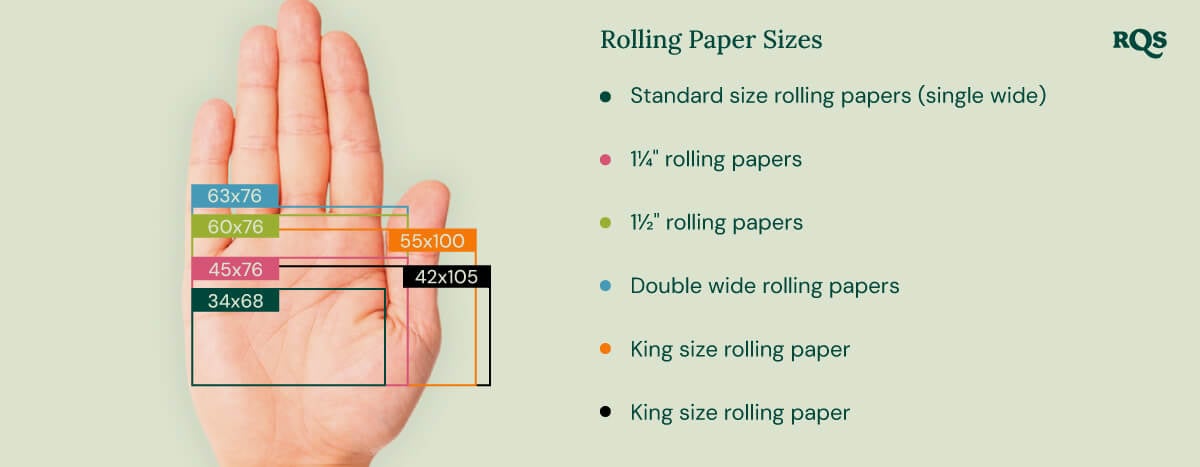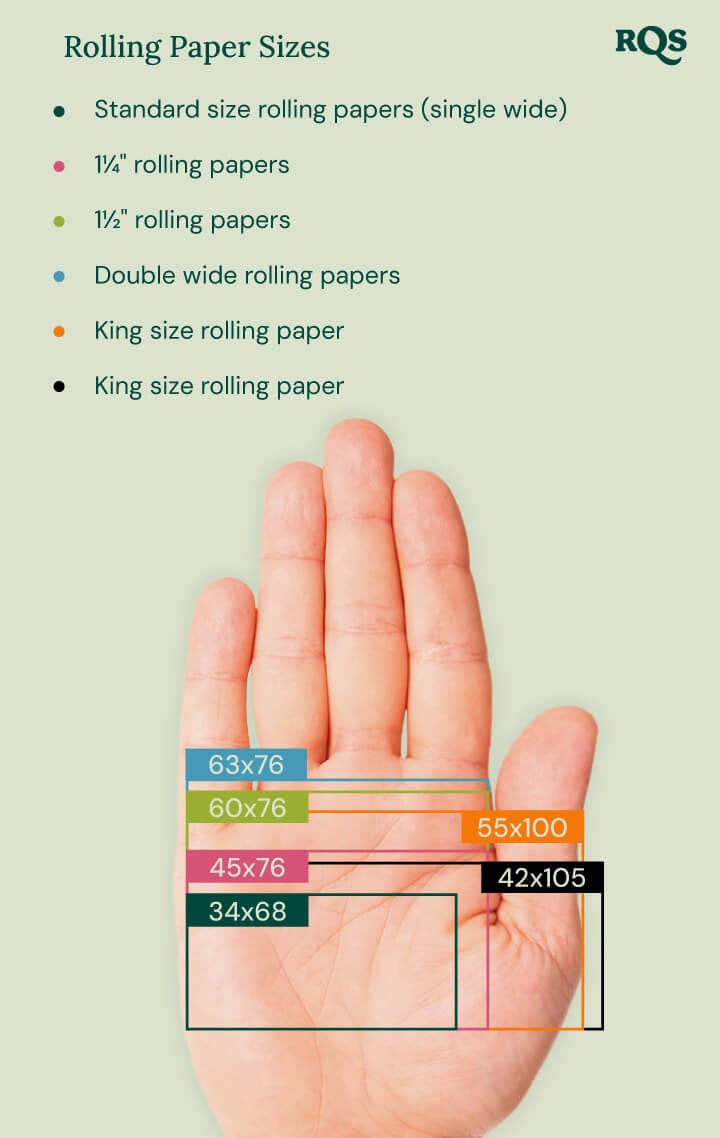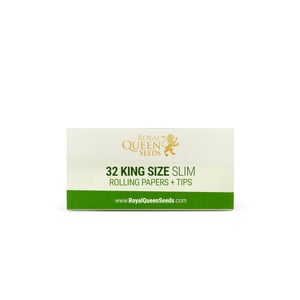.

The Different Kinds Of Rolling Papers Explained
Overwhelmed by the sheer amount of rolling papers for sale at smoke shops? In this article, we'll walk you through the different types of rolling papers, and examine how they might affect your smoking experience. This way, you can make an informed buying decision when it comes time to pick up your next pack of papers.
A good rolling paper can improve the quality of your joint and your overall smoking experience. However, no fine paper can substitute the skill required for a well-rolled joint, and learning how to craft impeccable roll-ups can take years. Despite the recent vaporiser boom, smoking cannabis in joints is still the most common way to benefit from cannabinoids together with all the aromas this plant offers us.
Traditional rolling papers are made from wood pulp, which has pros and cons when it comes to smoking. In the last 20 years, more and more cannabis-focussed, health-conscious papers have entered the market, with rice, hemp, and even transparent cellulose rolling papers produced to satisfy the demands of a more conscious public. Each kind of rolling paper has its own unique characteristics that appeal to different kinds of smokers. For example, taste, thickness, and burning speed of the paper are various features that come down largely to personal taste. To help you make an informed decision when buying your next pack of papers, here is a list of the most common materials and their characteristics.
Contents:
Common Characteristics of Rolling Papers
If you've ever stepped into a smoke shop, you'll know that there are hundreds (if not thousands) of rolling papers on the market, and they all claim to offer something unique. And while they might all look similar, rolling papers can vary quite significantly. Some notable characteristics that might impact your buying decision when it comes to choosing a rolling paper include size, flavour, style/form, and colour/design.
-
Size
Rolling papers typically come in the following pre-cut sizes:


-
Flavour
From fresh menthol to dark chocolate, rolling papers come in many flavours, including:
|
|
Of course, many rolling papers do not come with any added flavour, other than that of the paper itself.
-
Style
Rolling a smoke can be tricky, and it takes time and patience to learn. If you haven't yet gotten your rolling down pat, or you prefer to leave it up to the experts, pre-rolled cones or wraps are a great choice. Simply pack them with your favourite herb, twist the tip, and enjoy a perfect smoke in minutes! Alternatively, if you prefer to roll from a flat sheet of paper, you’ll find booklets that are reliable and easy to travel with.
-
Colour and Design
Rolling papers come in a variety of colours, from plain white or brown (unbleached) to more elaborate stamped papers with unique designs. Furthermore, you can even find pre-rolled cones measuring a whopping 24" (~61cm) to pass around during parties, or gold leaf papers to experience what it’s like to live the high life.
White vs Brown Rolling Papers: What's the Difference?
Rolling papers may have different porosity to control ventilation and burning rate. Apart from this, the paper can contain additional substances that slow down the burning, stabilise the paper itself, its smoke, and its ash. White rolling papers usually have a chemical aspect because of the presence of chlorine or calcium carbonate, which help slow down the burn. Flavoured and coloured rolling papers also contain chemicals, or even natural substances that have no real reason to be inhaled. Nowadays, many papers from respectable brands are made without chemical treatments or materials that improve combustion, reducing the possible harm and aftertaste of your smoke.
Most Common Rolling Paper Materials
Below is a breakdown of the most common materials used to create rolling papers. Some are more popular than others, and some are subject to significant chemical treatment while others are kept relatively unprocessed. Furthermore, each type of paper has a slightly different burn rate and porosity.
1. Classic Wood Pulp Paper |
At one point in history, wood pulp rolling papers were among the most popular, and they continue to be used to this day. They are often mixed with other fibres, giving them a texture makes them easy to handle. On average, these papers are thicker than other, newer types, even if they are available in a few different thicknesses—bleached or unbleached. White wood pulp papers are bleached, while brown ones are not. Wood pulp is solid, and the handy texture of these papers makes them convenient for beginners because they hold their shape well, even in presence of a little humidity or shaky, sweaty hands. Wood pulp papers have a medium–fast burn rate and are considered less desirable among most smokers compared to other materials.
2. Barely There Rice Paper |
The best rice papers are made from all-natural ingredients, meaning it’s basically just processed and pressed rice. These rolling papers are usually thinner than others, which is a good thing for your lungs but may require a little more effort when rolling. This smooth paper might not grip well between your fingers and is pretty vulnerable to certain conditions, especially damp air. Forget smoking with these papers when it’s raining outside. Rice paper is thin yet burns slowly. The little material used for a single sheet makes it a potentially better choice for your health, and for enjoying your weed without almost any external aftertaste.
3. Silky Smooth Flax Paper |
A similar result can be achieved with flax, which is sometimes used in rolling paper blends. There are indeed rolling papers made from 100% flax that can be considered a nice alternative to rice papers. The flax plant is well-known for producing flax seeds, a highly nutritious food that can be processed into a rich oil with a load of potential benefits. Flax fibre is made from the plant's natural long stems, and can be processed into a durable, lightweight, and ultra-fine paper. While they're not super popular, flax papers have a unique, silky texture that feels great in the hands and makes for easy rolling. Flax papers burn nice and slowly, giving you more time to enjoy your smoke, and are also flavourless, meaning they won't impact or alter the flavours/aromas of your herb in any way.
4. Hemp Is a Smoker's Friend |
Industrial hemp has proudly resurged in the last 20 years, and hemp rolling papers were immediately appreciated by the community. First off, these papers help to save trees, as they are made from hemp fibre, not wood pulp. Their colour is mainly light brown because the bleaching process is usually not appreciated by cannabis consumers. Hemp papers are thicker and rougher than rice ones, providing a good grip when rolling. However, they have a similar tendency to absorb (and eventually release) humidity. They have a medium burn rate and go out less often than rice papers. Joints made with hemp papers might take on a delicate aftertaste that won't spoil the aroma of the burning herb.
5. Old-School Esparto Paper |
Esparto, also known as halfah grass, is a tall perennial grass grown as a crop in North Africa, Spain, and Portugal. Esparto is usually used to make baskets, cardboard, and even clothing, but it can also be processed into paper. To make paper, esparto is typically mixed with roughly 5–10% wood pulp for easier processing. And while esparto paper production dates back many years, esparto rolling papers are very uncommon. And for good reason; esparto has been shown to produce highly carcinogenic smoke when burned. Hence, we do not recommend using esparto papers for smoking!
How Are Rolling Papers Produced?
As we just saw, rolling papers can be made from a variety of different fibres. In fact, many rolling paper manufacturers opt to use blends of fibres to create a finished product with the right texture and burn for smoking. Some fibres (such as wood pulp, in particular) burn very quickly, while other fibres (such as hemp) have a much slower burn. For smoking, you'll want a paper with a slow and even burn to preserve the flavours of whatever you're smoking.
To actually make their papers, manufacturers make a pulp from the selected fibres, which they then dry and press into a fine paper. Many rolling papers are also treated with chemicals to affect the burn, colour, and flavour of the final product, though not all are.

What Toxic Ingredients Are in Rolling Papers That You Should Avoid?
Note that smoking is always toxic, regardless of what herb you're smoking and what rolling material(s) you're using. When you combust plant material, the high heat from your lighter or match catalyses a bunch of reactions that essentially alter the chemicals in whatever you're smoking. The resulting smoke—while also containing terpenes, flavonoids, and, in the case of cannabis, cannabinoids—contains a wide variety of toxic compounds, many of which have been shown to be carcinogenic.
Nonetheless, if you smoke, there's no need to add fuel to the fire (pun intended). By choosing high-quality, natural smoking materials, you can enjoy a better-tasting and smelling smoke while also minimising your exposure to toxic chemicals. Some chemicals to avoid in rolling papers include:
- Heavy metals: Heavy metals such as arsenic, mercury, lead, and cadmium (all of which have been found[1] to be present in some rolling papers) are known to be extremely toxic to humans and many other life forms as well.
- GMO fibres: While the health effects of consuming genetically modified products is a highly debated topic, we at RQS are fans of keeping things as natural as possible. Hence, we encourage all smokers to seek out GMO-free products whenever possible.
- Artificial dyes: While some coloured papers may be made with natural dyes (like those used in food colourings, for example), others are made with harsh chemical dyes that are far from fit for human consumption. If you like to use coloured papers, look for products made with natural dyes.
- Bleach and calcium carbonate: Many commercial rolling papers are bleached to give them a pure, white colour. The most common chemical used to bleach rolling papers is chlorine, which is highly toxic and produces toxic fumes. To limit your exposure to excess chemicals when smoking, consider using unbleached papers. Calcium carbonate is also commonly used to bleach rolling papers and produce a slow, even burn. Paper treated with calcium carbonate becomes increasingly porous, which in turn affects the exchange of gases as the roll-up burns. Unfortunately, calcium carbonate irritates the skin and eyes in direct contact, as well as the respiratory tract when inhaled. When combusted, calcium carbonate produces irritating smoke.
- Potassium nitrate: Flavoured papers (particularly blunt wraps) often contain potassium nitrate, which is highly toxic. In its natural form, potassium nitrate irritates the skin and eyes upon contact, and the nose, throat, and lungs when inhaled. In high concentrations, potassium nitrate can affect oxygen transportation around the body and cause anaemia and even death.
That's a Wrap!
There's no shortage of variety when it comes to rolling papers. Choosing one type or brand of paper over another often comes down to personal preference in terms of the size, flavour, or colour of the paper as well as how it burns and, of course, the price. However, where possible, we recommend steering away from bleached or heavily processed rolling papers to preserve the flavour of your smoke and avoid exposing yourself to excess chemicals.
- Lab Analysis: Some Rolling Papers Contain Unwanted Contaminants - NORML https://norml.org








































